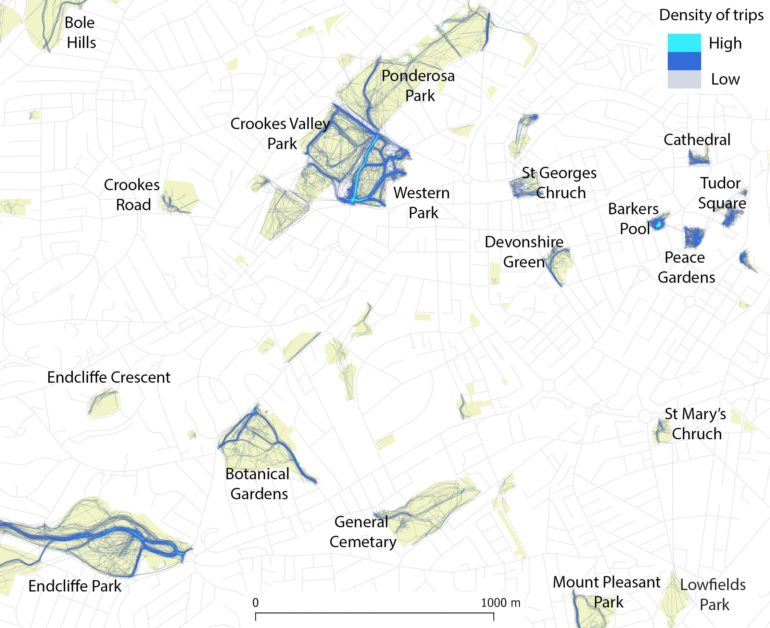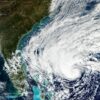GPS data from cell phones may provide insight into how city inhabitants are using their urban greenspaces, in a study published July 7, 2021 in the open-access journal PLOS ONE by Meghann Mears and Paul Brindley from the University of Sheffield, UK, and colleagues.
Urban greenspaces confer a range of health and well-being benefits on city inhabitants and provide connection to nature. In this study, Mears and colleagues use cellphone GPS data to assess how frequently residents of the city of Sheffield in the UK engage with their local urban greenspaces, and whether this engagement was different across demographic groups.
The authors used the “Shmapped” app, developed as part of the Improving Well-being through Urban Nature project, to track how frequently 240 users based in Sheffield who had downloaded the app visited or traveled near any of the 945 green/open spaces identified by the Sheffield City Council from July 1, 2017-October 6, 2018. Of these 240 Shmapped users, 156 were male, 81 female; 214 were white, 21 were Black, Asian, or another ethnic minority; 126 were ages 18-33, and 112 were ages 34-71.
After cleaning their data, the authors were left with 5,186 valid trips. The median trip length was 190 meters and the median duration 4 minutes 36 seconds; the average Shmapped user made just over one trip per day to a greenspace, with a weekly total duration of nearly an hour and total distance of around 2.5 km. Gender, age, and ethnicity all had a significant effect on the total duration (average trip duration multiplied by trip frequency) of users’ trips to greenspaces: women’s trips were on average 30 percent longer than men, people aged 34 and over made trips 31 percent longer than younger users, and ethnic minority users spent 34 percent less time making trips to greenspace than white users. The authors also found significant demographic effects in terms of total trip distance (average trip distance times trip frequency): women’s trip distance was 29 percent longer than that of men; people aged over 34 traveled 39 percent further than those under 34; and ethnic minority greenspace users traveled 34 percent more distance than white users. Interestingly, people who spent more time outside as a child also traveled 40 percent further than those who spent less time outside.
The green spaces identified by Shmapped don’t include the extensive countryside areas surrounding Sheffield, in easy visiting distance for many of the city’s residents; the app was also not able to track any Sheffielders’ visits to out-of-town green spaces. Additionally, all users were self-selected, so the user makeup is not an accurate general reflection of Sheffield’s population. Lastly, the authors note that they weren’t able to capture the users’ reasons behind each visit, information that would be extremely useful for this type of analysis.
However, the results thus far indicate that most day-to-day greenspace visits within Sheffield are incidental (due to traveling through the area, rather than a specific visit to the area), and highlight the importance of including social and cultural factors when investigating who uses and who benefits from urban greenspace. The authors note that many reasons are likely behind the observed demographic differences in greenspace use, including socioeconomic factors, differing cultural norms, and the legacy of discrimination.
The authors add: “The paper outlines a method to clean GPS data to identify trips within urban greenspaces and shows that local users of the app spend an average of an hour per week visiting greenspaces, including around seven trips per week and covering a total distance of just over 2.5 km. Most day-to-day visits to urban greenspace are incidental, i.e. traveling through rather than to greenspace.”
Walkability is key: A look at greenspace use
More information:
Mears M, Brindley P, Barrows P, Richardson M, Maheswaran R (2021) Mapping urban greenspace use from mobile phone GPS data. PLoS ONE 16(7): e0248622. doi.org/10.1371/journal.pone.0248622
Provided by
Public Library of Science
Citation:
Mapping urban greenspace use with cellphone GPS data (2021, July 7)
retrieved 7 July 2021
from https://techxplore.com/news/2021-07-urban-greenspace-cellphone-gps.html
This document is subject to copyright. Apart from any fair dealing for the purpose of private study or research, no
part may be reproduced without the written permission. The content is provided for information purposes only.



